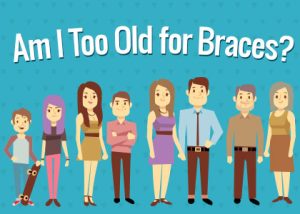Am I Too Old for Braces?
Posted on November 13th, 2023
 How old is too old for braces? It’s an interesting question—and the answer may surprise you! Veranda Dentistry in Des Moines would like to share some information with readers today regarding patient age as it relates to orthodontic treatment.
How old is too old for braces? It’s an interesting question—and the answer may surprise you! Veranda Dentistry in Des Moines would like to share some information with readers today regarding patient age as it relates to orthodontic treatment.
Spoiler Alert!
Patient age alone is not a deal-breaker when it comes to successful orthodontic treatment outcomes, so what’s the determining factor? Simply put— the health of gums and bone. For example, if a patient has uncontrolled periodontal (gum) disease, the moving of teeth within the bone caused by orthodontic appliances can aggravate gum disease symptoms. Other medical conditions or medications can also interfere with orthodontic treatment. Some of these include:
- Severe heart valve disease
- Bleeding disorders
- Severe and uncontrolled diabetes
- Leukemia
Some medications used to treat arthritis and osteoporosis make moving teeth more difficult, so your dentist or orthodontist needs full disclosure of all medications you take before you begin any treatment. Smoking cigarettes and certain other medications can dry out the mouth, increase your risk of tooth decay and make orthodontic treatment less comfortable. Be sure to give Veranda Dentistry all your medical information—including medications you are taking—upfront before starting treatment.
What are the Benefits of Adult Braces?
Malocclusion—which doesn’t only apply to crooked teeth, but a bad bite—affects approximately 75% of adults. About 1 in 5 orthodontic patients are adults over the age of 21. That’s a lot of grown-up braces!
- Orthodontia can correct the bite. A bad bite can be genetic, result from overcrowded teeth, or develop when lost teeth leave gaps in the gums behind. The remaining teeth slip into these empty spaces simply because they remain empty. Adult braces can correct the bite and move teeth where they should be for a healthy bite.
- Straight teeth are easier to clean. Brushing and flossing are much easier to do effectively when teeth are evenly aligned in the mouth, so your risk for tooth decay and gum disease decreases significantly.
- Enjoying food by chewing and swallowing comfortably is one of life’s simpler pleasures. A person whose bite isn’t functional is likely to become discouraged when faced with this problem—multiple times per day, every day.
- Orthodontia—or more accurately, the results of orthodontia—can cause a big spike in self-assurance. People who like their smiles may find it difficult to stop smiling! Personal appearance, self-esteem, and confidence can skyrocket once teeth are straighter. Straightening your smile can actually be life-changing!
What Are the Drawbacks of Adult Orthodontia?
Because adult bones are no longer growing, some structural changes in the jaw and mouth cannot be accomplished without surgery. Treatment times may take longer in older patients due to fighting gum disease or bone loss.
Hey, Get Off My Lawn!
Braces are not just for children and teens anymore. Regardless of your age, if your teeth bother you enough to want to correct your malocclusion—you should do it! Crooked and misaligned teeth can contribute to gum and bone loss, tooth decay, premature and excessive tooth wear, headaches, and jaw joint issues like TMJ. These are dental problems no one of any age wants!
Technology has grown by leaps and bounds since most of us were kids. Today’s braces are not necessarily the metal and wire contraptions catching every camera flash or trapping food at the worst possible times. While certain dental situations call for more traditional braces, they are smaller and less invasive than ever. Different orthodontic options have evolved over time that have a more discreet appearance, often require shorter treatment times, and can be easier to care for.
Different Types of Braces
Clear Aligners
Invisalign® and ClearCorrect™ are two popular orthodontic treatments that use clear, custom-fitted aligners to straighten teeth. The aligners are removable, easy to clean, and do not require additional dietary restrictions. They are also nearly invisible due to their clear construction of medical-grade plastic. Millions of people have successfully used these systems to achieve more beautiful smiles—and treatment times average only about a year!
Colorless or Tooth-Colored Braces
Six Month Smiles® is one example of a system using tooth-colored or clear brackets and wires for a short-term orthodontic treatment that improves the alignment of visible teeth. Because the focus is on only the front teeth that show when you smile, the treatment time is much shorter (average treatment times of six months, hence the name) and they’re much less noticeable than traditional braces.
If you are an adult considering straightening your teeth, call Veranda Dentistry with any questions or to schedule an appointment today!
The content of this blog is not intended to be a substitute for professional medical advice, diagnosis, or treatment. Always seek the advice of qualified health providers with questions you may have regarding medical conditions.


